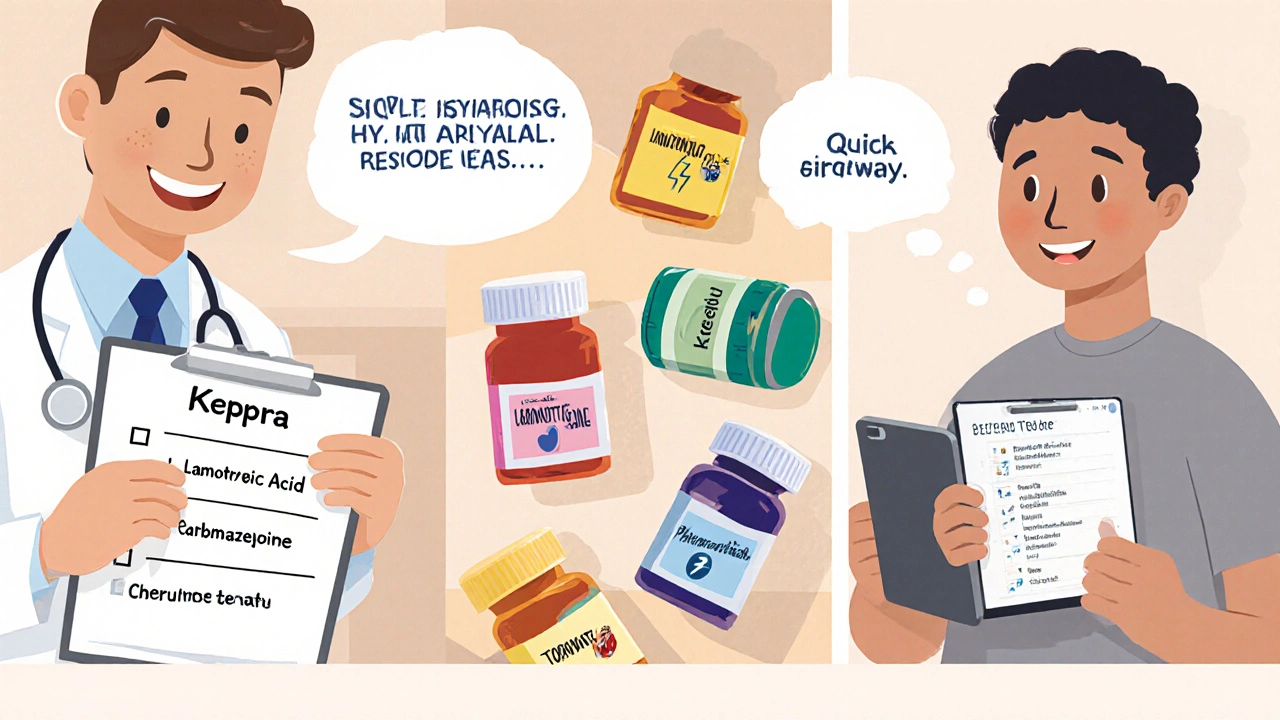
AED Selection Advisor
Find Your Best Anti-Epileptic Drug Match
Answer these questions to see which anti-epileptic drugs might be most suitable for your situation. This tool is not a medical recommendation—always discuss treatment options with your doctor.
Your Recommended Anti-Epileptic Drugs
Note: This tool provides general guidance based on the article content. Always consult your neurologist or healthcare provider for personalized treatment recommendations. Never adjust your medication without medical supervision.
Quick Takeaways
- Keppra is praised for minimal drug interactions and rapid titration, making it a first‑line option for many seizure types.
- Older drugs like carbamazepine and phenytoin are cheap but carry higher interaction risk.
- Valproic acid offers broad coverage of seizure types but can cause weight gain and liver issues.
- Lacosamide and topiramate provide newer mechanisms with specific niche uses.
- Choosing the right drug depends on seizure type, comorbidities, lifestyle, and cost.
When your neurologist says “we need to pick a seizure medicine,” you probably end up Googling “Keppra vs alternatives.” This guide walks through the most common AEDs side‑by‑side, so you can ask the right questions at your next appointment.
Keppra is the brand name for levetiracetam, a second‑generation anti‑epileptic drug approved by the FDA in 1999. It works by binding to the synaptic vesicle protein SV2A, modulating neurotransmitter release and stabilising neuronal firing.
How Keppra Works and Who It Helps
Levetiracetam’s unique target means it doesn’t affect liver enzymes much, so it rarely interacts with other meds. That’s why doctors often start adults on 500 mg twice daily and increase by 250 mg every week until seizures are controlled.
Keppra is FDA‑approved for:
- Partial‑onset seizures with or without secondary generalisation
- Myoclonic seizures (especially in juvenile myoclonic epilepsy)
- Primary generalized tonic‑clonic seizures
Because it can be titrated quickly, many patients see seizure reduction within a few weeks.
Key Criteria for Comparing Anti‑Epileptic Drugs
When you line up Keppra against its competitors, consider these six factors:
- Efficacy for specific seizure types
- Side‑effect profile (both common and severe)
- Potential drug‑drug interactions
- Typical dosing regimen and titration speed
- Cost and insurance coverage
- Special warnings (pregnancy, liver disease, renal impairment)

Head‑to‑Head Overview of Popular Alternatives
Below is a snapshot of five widely used AEDs that clinicians often consider alongside Keppra.
Lamotrigine is a phenyltriazine derivative that blocks voltage‑gated sodium channels, reducing neuronal excitability.
- Best for: Focal seizures, absence seizures, and as mood stabiliser in bipolar disorder.
- Common side effects: Rash (rarely Stevens‑Johnson syndrome), dizziness, blurred vision.
- Interactions: Strong CYP3A4 inducers (e.g., carbamazepine) lower its levels.
Valproic Acid (also sold as Depakote) enhances GABA activity and blocks sodium channels.
- Best for: Generalised tonic‑clonic, myoclonic, and absence seizures.
- Common side effects: Weight gain, tremor, hair loss, hepatotoxicity.
- Interactions: Numerous - especially with other AEDs and anticoagulants.
Carbamazepine is an iminostilbene that blocks sodium channels and is a strong CYP3A4 inducer.
- Best for: Focal seizures, trigeminal neuralgia.
- Common side effects: Drowsiness, hyponatraemia, diplopia.
- Interactions: Lowers levels of many drugs, including oral contraceptives.
Phenytoin works by stabilising neuronal membranes via sodium channel blockade.
- Best for: Focal seizures, status epilepticus (IV).
- Common side effects: Gingival hyperplasia, hirsutism, neuropathy.
- Interactions: Strong inducer of CYP enzymes, many drug‑level adjustments required.
Topiramate inhibits carbonic anhydrase and blocks sodium channels, also enhancing GABA.
- Best for: Partial seizures, Lennox‑Gastaut syndrome, migraine prophylaxis.
- Common side effects: Cognitive slowing, kidney stones, weight loss.
- Interactions: Can increase plasma levels of oral contraceptives.
Side‑Effect Comparison Table
| Drug | Common Side Effects | Serious Risks | Pregnancy Category |
|---|---|---|---|
| Keppra | Drowsiness, irritability, dizziness | Rare severe rash, mood changes | Category C (use if benefits outweigh risks) |
| Lamotrigine | Rash, nausea, headache | Stevens‑Johnson syndrome (very rare) | Category C |
| Valproic Acid | Weight gain, tremor, hair loss | Hepatotoxicity, neural tube defects | Category D (avoid in pregnancy) |
| Carbamazepine | Drowsiness, ataxia, diplopia | Hyponatraemia, aplastic anemia | Category D |
| Phenytoin | Gingival overgrowth, hirsutism, tremor | Severe skin reactions, CNS toxicity | Category D |
| Topiramate | Paraesthesia, cognitive slowing, appetite loss | Kidney stones, glaucoma | Category C |
Cost Snapshot (US Dollar Approximation, 2025)
- Keppra: $150‑$250 per month (brand); $30‑$60 generic.
- Lamotrigine: $30‑$45 per month generic.
- Valproic Acid: $20‑$35 per month generic.
- Carbamazepine: $10‑$20 per month generic.
- Phenytoin: $8‑$15 per month generic.
- Topiramate: $25‑$40 per month generic.
Insurance coverage varies widely; many plans treat Keppra as a preferred drug, but the brand price can still be a barrier without prior authorization.
Decision Matrix: When to Choose Keppra vs an Alternative
- Rapid titration needed - Keppra or topiramate work best.
- Patient on multiple meds (e.g., antidepressants) - Keppra’s low interaction profile is a win.
- History of liver disease - Avoid valproic acid; consider Keppra or lamotrigine.
- Pregnant or planning pregnancy - Lamotrigine or carbamazepine (Category C) are safer than valproic acid.
- Cost‑sensitive with good insurance - Carbamazepine or phenytoin are cheapest but require monitoring.
How to Switch Safely from Keppra to Another AED
Never stop Keppra abruptly; seizure control can rebound. A typical taper looks like this:
- Reduce dose by 25 % every 1‑2 weeks while introducing the new drug at a low dose.
- Monitor seizure frequency and side‑effects closely for at least 4 weeks.
- Complete the Keppra taper only after the new drug reaches therapeutic level.
Keep a seizure diary and share it with your neurologist. Blood level checks are rarely needed for Keppra but may be required for carbamazepine, phenytoin, or valproic acid.
Frequently Asked Questions
Is Keppra better than valproic acid for generalized seizures?
Both work, but valproic acid covers a broader range of generalized types. Keppra is often chosen when the patient needs fewer drug interactions or has liver concerns. Efficacy is similar for many patients, so the decision usually hinges on side‑effect tolerance and comorbidities.
Can I take Keppra with oral contraceptives?
Yes. Keppra does not lower contraceptive hormone levels, unlike enzyme‑inducing drugs such as carbamazepine.
What is the most common reason patients stop Keppra?
Behavioural changes - irritability or mood swings - are reported in up to 15 % of users and often prompt a switch.
Does kidney function affect Keppra dosing?
Yes. Keppra is cleared renally, so patients with a creatinine clearance below 30 mL/min need a 50 % dose reduction.
Are there any food restrictions while on Keppra?
No. Unlike some AEDs, Keppra can be taken with or without food.
Armed with this side‑by‑side look, you can now sit down with your neurologist and talk specifics - not just “which drug is best?” but “which drug fits my life, my health history, and my budget.” If you’re still unsure, ask for a trial period; many doctors will prescribe a short‑term supply to see how you tolerate the medication before committing to a longer course.
14 Comments
Jay Kay
October 24, 2025 at 07:38 AM
Keppra is just another pill that pretends to be miracle but in reality it’s just hype.
Nicole Boyle
October 28, 2025 at 21:45 PM
The pharmacokinetic profile of levetiracetam, characterized by negligible CYP450 modulation, confers a distinct advantage in polypharmacy contexts, especially when juxtaposed against enzyme-inducing agents such as carbamazepine; however, renal clearance considerations necessitate dose adjustments in nephropathic cohorts.
Caroline Keller
November 2, 2025 at 12:51 PM
We cannot ignore the silent suffering of patients forced onto drugs that steal their mood and agency Keppra may spare liver but it can still hijack your emotional equilibrium and that is unacceptable
ashanti barrett
November 7, 2025 at 03:58 AM
I hear the concern about mood swings and I’d say if you notice irritability early you should flag it with your neurologist; adjusting the dose or switching can preserve quality of life.
Leo Chan
November 11, 2025 at 19:05 PM
Stay positive and keep a seizure diary it’s the best tool you have; tracking patterns often reveals that a small tweak in dosing can make a huge difference in control.
Sarah Unrath
November 16, 2025 at 10:11 AM
Keppra isn’t the cheapest option.
James Dean
November 21, 2025 at 01:18 AM
Levetiracetam entered the market with promises of simplicity and it delivered in many ways. Its binding to SV2A is a unique mechanism that sidesteps the traditional sodium channel blockade seen in older agents. Because it does not rely on hepatic metabolism the drug avoids the cascade of cytochrome interactions that plague carbamazepine and phenytoin. Patients with polypharmacy often find this attribute to be a lifesaver when other conditions require concurrent therapy. The rapid titration schedule allows clinicians to reach therapeutic doses within weeks rather than months. Clinical trials have repeatedly shown comparable seizure reduction rates to valproic acid in generalized epilepsies. Yet the side effect profile is not without its quirks; irritability and mood dysregulation appear in a notable minority. Some clinicians argue that these neuropsychiatric effects are under‑reported because they manifest subtly. The renal clearance pathway means dose reductions are mandatory in patients with impaired kidney function, a point often missed in primary care settings. Cost remains a barrier for many, especially when brand name pricing dominates formularies. Generic levetiracetam has narrowed the gap but insurance mandates can still create hurdles. In pregnancy the drug sits in category C, prompting cautious use despite its low teratogenic signal compared to valproic acid. Switching off Keppra should never be abrupt; a gradual taper mitigates rebound seizure risk. Lifestyle factors such as alcohol consumption do not significantly alter its pharmacodynamics, offering flexibility. Overall the drug’s balance of efficacy, safety, and tolerability makes it a strong contender for first‑line therapy. Physicians must, however, remain vigilant for the less obvious neurobehavioral changes that can erode patient wellbeing.
Monika Bozkurt
November 25, 2025 at 16:25 PM
Thank you for the comprehensive overview; your delineation of pharmacokinetic considerations aligns with current consensus and emphasizes the necessity of renal dose adjustments and vigilant monitoring of neuropsychiatric sequelae.
Penny Reeves
November 30, 2025 at 07:31 AM
While the exposition is exhaustive it borders on redundancy; most clinicians already internalize these nuances without the need for such verbosity.
Ankitpgujjar Poswal
December 4, 2025 at 22:38 PM
Listen up you don’t need to reinvent the wheel just because the article is lengthy; focus on the key takeaways and apply them with confidence.
Bobby Marie
December 9, 2025 at 13:45 PM
its good but dont overthink it
Christian Georg
December 14, 2025 at 04:51 AM
Glad to see the discussion evolving 😊. Remember, consistent diary entries and regular follow‑ups are the cornerstone of effective AED management; they help differentiate drug‑related side effects from seizure variability.
Christopher Burczyk
December 18, 2025 at 19:58 PM
In summary the presented data, though thorough, ultimately reinforces the established hierarchy of anti‑epileptic drugs without offering novel insights.






jagdish soni
October 19, 2025 at 16:31 PM
Ever wondered why the pharmaceutical market treats seizures like a fashion runway the way Keppra strides in with barely a whisper of interaction it feels almost poetic how simplicity can masquerade as superiority